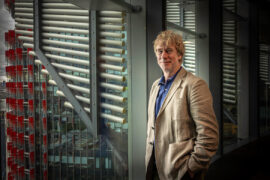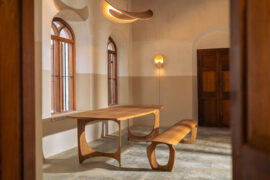The International Space Station is a 40-year design experiment in creating the ultimate environment to work, live and play. The result? Perfect agility. Too perfect. Astronauts want to know if we’ve told Houston, ‘there’s a problem’.
February 24th, 2017
The degree to which space exploration has shaped your workplace cannot be overstated. We like to flatter ourselves with airs of (apparently) only just yesterday having created design solutions to allow collaboration, moving target objectives and intuitive transformation for the modern workplace to flourish. Well, I’m sorry to tell you, kid – but NASA has been toying with hardcore workplace agility as far back as the early 70s.
Launched almost 30 years ago in 1998, The International Space Station (ISS) is undoubtedly a marvel of architecture and design. Ignore that it’s larger than a football field. Also ignore that of its 935 cubic metres of pressurised space and spacecraft infrastructure, the design principles of the ISS have created the first blueprint of what we now call agile working.
The ISS is one colossal hot desk; so modular, dynamic and flexible it accommodates a constantly rotating nomadic workforce. In fact, during a recent study of 12 ISS astronauts and cosmonauts in orbit, researchers reported that all crew exhibited an increased homogeneity in values, reluctance to express negative interpersonal association and a concomitant increase in work autonomy and virtual leadership – overall, a positive tendency toward ‘groupthink’.1 Productivity? Tick. Collaboration? Tick. In communication with NASA Mission Control to monitor Environmental Control and Life-Support System [ECLSS], the crew spend their time working on experiments in the various laboratory wings of the Destiny Module and the Zvezda Service Module that also houses living quarters, the galley and utilities – all so extremely modular that furniture is minimal to almost non-existent. Spatial economy and reduced overheads? Tick. Creating ‘zoned activity’ areas? Tick. Virtual connectivity? Tick.
But, here is where designers have some explaining to do. Because the agile model is (officially) only quite young in our workspaces on Earth, we lack indication for how both agile designs and agile operations affect us long-term. The ISS, then, presents us with the evidence of an entire workforce generation bred entirely agile. Unfortunately, the results aren’t pretty. While the spatial attuning of the ISS provides zones for collaboration, refuge, communality, focus and retreat, the interface between the human body and the designed space is far from fluid or salubrious. Recently, NASA reported that while the operational models afforded by the design of the ISS allowed ‘groupthink’ to flourish, crew members confirmed increased feelings of loneliness, lower support from colleagues over time and a negative effect on cognitive adaptation.2
Under not dissimilar occupational conditions, Buzz Aldrin (Apollo 11) famously touched back down on earth, turned to liquor, suffered depression, anxiety, and became a car salesman in Texas. Edgar Mitchell (Apollo 14) spent the last of his days threatening journalists with lawsuits and rifles, yammering on about the CIA covering-up extra-terrestrial activity. Cosmonaut Valentin Lebedev (Salyut 7) spiralled into depression on the ISS and disassociated himself from the rest of his crew. Lisa Marie Nowak (STS-121) gained international attention after being arrested (in space diapers, no less) for her attempted kidnapping, burglary, battery and assault of U.S. Air Force Captain, Colleen Shipman. And, perhaps, the recent most despairing report: through years of crippling depression, pain and paralysis after returning to Earth, in 2006 Dr. Charles E. Brady (STS-78) committed suicide.
Behavioural psychologists are reporting that in agile workspaces across Earth – in addition to increased disruption, stress, and dissatisfaction3 – there is an overwhelming trend toward deindividuation, dissociation, depression and occupational rootlessness.4 The agile worker is fated to be free – a high-functioning itinerant working everywhere and nowhere – where zero-gravity freedom has become captivity. We have designed a workplace in which the extensive totality of work is no longer directly accessible. A workplace in which personal fulfilment in work has become a problem because we’ve designed a material world which disavows the personal. A world where flexibility is starting to look like another word for submissiveness. Modularity, segmentation. Collaboration, deindividuation.
The ISS is all at once the most experimental and the most expensive single item and single workplace we have ever designed. But in our over-enthusiasm to continually remake it today on our doorstep, none of us have seemed to realise there might be something wrong. That it might be too late. That it might be a dead circuit. Can you hear me, Major Tom?
Want more? Grab a copy of Indesign #68 to read the full story!
INDESIGN is on instagram
Follow @indesignlive
A searchable and comprehensive guide for specifying leading products and their suppliers
Keep up to date with the latest and greatest from our industry BFF's!

London-based design duo Raw Edges have joined forces with Established & Sons and Tongue & Groove to introduce Wall to Wall – a hand-stained, “living collection” that transforms parquet flooring into a canvas of colour, pattern, and possibility.

Welcomed to the Australian design scene in 2024, Kokuyo is set to redefine collaboration, bringing its unique blend of colour and function to individuals and corporations, designed to be used Any Way!
The new range features slabs with warm, earthy palettes that lend a sense of organic luxury to every space.

For Aidan Mawhinney, the secret ingredient to Living Edge’s success “comes down to people, product and place.” As the brand celebrates a significant 25-year milestone, it’s that commitment to authentic, sustainable design – and the people behind it all – that continues to anchor its legacy.

‘The Mandate Mirage: 2025 Workplace Futures Survey’ is a new report by international design practice Hassell, revealing that the real drawcard for attracting employees to the office in-person is choice.

The Senior Design Director at RSHP reflects on Barangaroo South Masterplan during a visit to Sydney marking ten years since the completion of the first phase.
The internet never sleeps! Here's the stuff you might have missed

From Australian architects to Spanish and Indian designers, Design Mumbai 2025 expands its international reach — proving India’s growing role on the global design stage.

Join CPD Live from 14-16 October for three days of live, interactive education – 100% online, 100% free, and packed with insights to keep your knowledge current and earn CPD points.